
Marwell Zoo is a 140-acre (57 ha) zoo situated in Colden Common near Winchester, in the English county of Hampshire. It is owned and run by the registered charity Marwell Wildlife. The zoo is home to 1,208 animals of 149 species. The charity undertakes a range of educational and conservation activities, with a particular focus on Africa in addition to work from its base.

Colchester Zoo is a zoological garden situated near Colchester, England. The zoo opened in 1963 and celebrated its 60th anniversary on 2 June 2023. The zoo is home to many rare and endangered species, including big cats, primates and birds as well as many invertebrates and fish species.

Knowsley Safari is a safari park and tourist attraction near Prescot, England. It is a member of the British and Irish Association of Zoos and Aquariums (BIAZA) and the European Association of Zoos and Aquaria (EAZA). It contributes to conservation and research through links with conservation projects and its links with universities in nearby Liverpool, as well as Chester and Manchester. The Channel 4 series Secret Life of the Safari Park was filmed here.
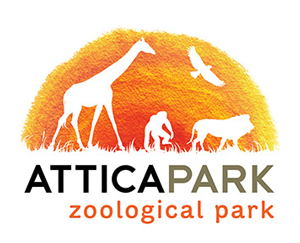
Attica Park, officially Attica Zoological Park (AZP), is a private zoo located in the suburb of Spata, approximately 20 kilometres (12 mi) east of Athens, Greece. It is the only zoo in Greece. The zoo is home to more than 1,500 animals representing 220 species, in an area of 20-hectares. It is open 365 days a year.
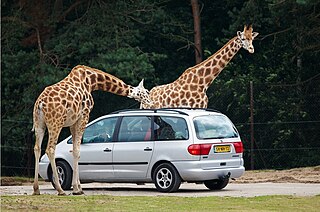
A safari park, sometimes known as a wildlife park, is a zoo-like commercial drive-in tourist attraction where visitors can drive their own vehicles or ride in vehicles provided by the facility to observe freely roaming animals.

La Palmyre Zoo is a zoo in Les Mathes, Charente-Maritime, near Royan, in southwestern France. It was created in 1966 in the forest of la Coubre by Claude Caillé. Extending over 18 hectares, including 14 of landscape garden, it offers the visitor the opportunity of observing more than 1600 animals of all kinds, divided into 145 species, over a distance of more than 4 kilometres (2.5 mi).

The Zoological Center Tel Aviv-Ramat Gan in the Tel Aviv District city of Ramat Gan, Israel, is the largest collection of wildlife in human care in the Middle East. The 250-acre site consists of both a drive-through African safari area and a modern outdoor zoo. The African animal park opened to the general public in 1974. In 1981, the zoo was established in the middle of the park to replace the Tel Aviv Zoo, which had closed down.
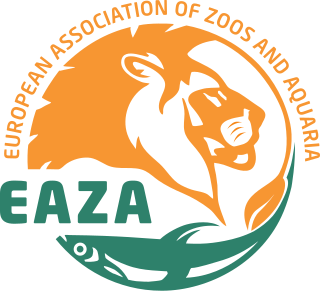
The European Association of Zoos and Aquaria (EAZA) is an organisation for the European zoo and aquarium community that links over 340 member organisations in 41 countries. EAZA membership is open to all zoos and aquaria across Europe that comply with EAZA's standards. The organisation is administered and headquartered at Natura Artis Magistra in Amsterdam, the Netherlands.
The Dutch Zoo Federation is an association of 12 large zoos in the Netherlands. NVD was founded in 1966. All of its member zoos are members of the European Association of Zoos and Aquaria (EAZA).

Woburn Safari Park is a safari park located in Woburn, Bedfordshire, England. Visitors to the park can drive through exhibits, which contain species such as southern white rhino, elephants, tigers and black bears. It is part of the estates of the Duke of Bedford that also includes Woburn Abbey and its 3,000-acre (1,200 ha) deer park. The Safari Park itself covers 360 acres (150 ha).

Royal Burgers' Zoo is a 45-hectare (110-acre) zoo in Arnhem, Netherlands, and is one of the biggest zoos in the country. Arnhem is a city that lies partially in the Veluwe, a nature park in the east of the Netherlands. The zoo is popular with both Dutch and German people, and receives about 1 million visitors annually. It was founded by Johan Burgers in 1913.
The EAZA Ex-situ Programme (EEP) is a population management and conservation programme by European Association of Zoos and Aquaria (EAZA) for wild animals living in European zoos. The programme was formerly known as the European Endangered Species Programme.

The ZooParc de Beauval, more commonly called Beauval Zoo or, more simply, Beauval, is a French zoological park located in Saint-Aignan-sur-Cher, Centre-Val de Loire. It features more than 35,000 animals on 40 hectares, which is one of the largest animal collections in France and in Europe. Created in 1980 by Françoise Delord, it is now run by her son, Rodolphe Delord, and managed by his family, which owns most of the capital.

DierenPark Amersfoort is a 20-hectare (49-acre) zoo located on the West side of Amersfoort, in the province of Utrecht, on the edge of the Birkhoven forest, in the Netherlands.
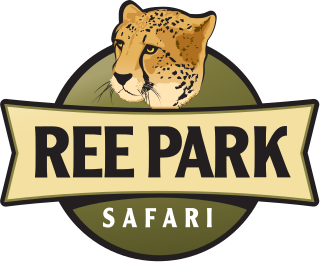
Ree Park Safari is a safari park in Djursland on the peninsula of Jutland, Denmark. The safari park is the home of more than 800 animals of 80 species from 5 continents. This popular tourist attraction offers its guests a comprehensive insight into the life and behaviour of animals from Europe, Africa, North America, South America and Asia.

Korkeasaari Zoo, also known as Helsinki Zoo, is the largest zoo in Finland, located in Helsinki. The zoo was first opened in 1889. Today it is operated by a nonprofit foundation.

Zodiac Zoos is a Dutch corporation that owns and operates Aqua Zoo Friesland, Zoo Wissel, Zoo Labyrinth Boekelo, Zoo Park Overloon, and Castle Arcen.
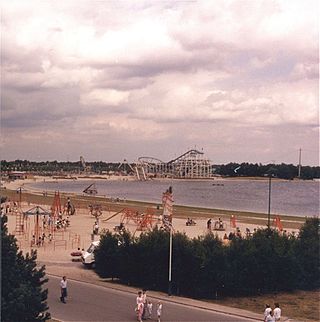
Speelland Beekse Bergen is an amusement park and playground near Hilvarenbeek, Netherlands. It is a part of the Beekse Bergen group, which also owns Safaripark Beekse Bergen. The park has been a part of Libéma Exploitatie since 1987. Speelland mainly has playgrounds, a beach, and water attractions.
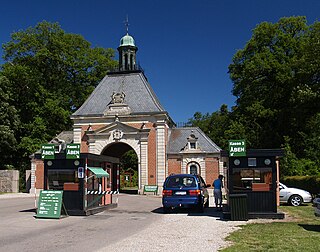
Knuthenborg Safaripark is a safari park on the island of Lolland in the southeast of Denmark. It is located 5 km (3.1 mi) to the north of Maribo, near Bandholm. It is one of Lolland's major tourist attractions with over 300,000 visitors annually, and is the largest safari park in northern Europe. Among others, it houses a drive-through safari park, a monkey forest, large enclosures for Siberian tigers and African bush elephants, the Dinosaur Forest with full-scale models, the Museum of Evolution with fossils of dinosaurs and other prehistoric animals, an arboretum, and the largest nature playground in Denmark. Knuthenborg covers a total of 660 hectares, including the 400-hectare (990-acre) Safaripark. The park is viewable on Google Street View.

Marius was a male giraffe living at Copenhagen Zoo. Though healthy, he was genetically unsuitable for future captive breeding, as his genes were over-represented in the captive population, so the zoo authorities decided to euthanize him. Despite several offers to adopt Marius and an online petition to save him, he was killed on 9 February 2014. His body was then dissected and necropsied in a public educational class and then fed to the zoo's lions. The event received worldwide media coverage and generated responses from several organisations and individuals, including death threats to staff at the zoo.




















